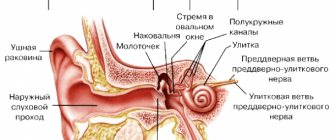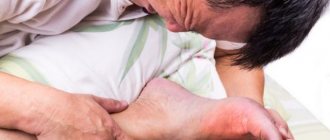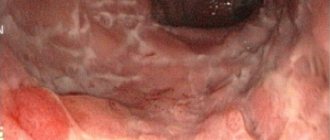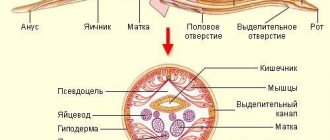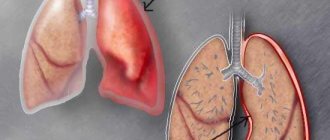Location of female reproductive organs
Women's ovaries are located symmetrically on either side of the lower abdomen. It is in the area where they are located that pain symptoms occur during inflammation of the ovaries in women. These glands have the same structure and functions; the volume of one organ can reach 12 ml. The right ovary is usually slightly larger than the left, and this is considered normal, because he is more active.
The ovaries contain many follicles that alternately mature in each menstrual cycle. The follicle fully matures in the last days before the ovulatory phase, and the ovulation process itself is characterized by the release of an egg from the ruptured follicle. If the menstrual cycle is disrupted, the follicles do not burst, which entails the inability to get pregnant. As a result of a prolonged course of this process, inflammation of the ovaries may develop.
Another function of the ovaries is hormonal. They produce progesterone, estrogens and androgens. Progesterone has a significant effect on the development of pregnancy and the formation of lactation, supporting the proper course of these processes by participating in the formation of the fetus, stimulating the onset of lactation and the manifestation of maternal instinct. Estrogens and androgens control the functioning of the genital organs, their development in adolescence and earlier periods, and are also responsible for the formation of secondary sexual characteristics and sexual behavior.
The corpus luteum forms immediately after the release of the egg to produce progesterone.
Fact! Androgens are male hormones that are also necessary for the female body. In the male body their number is tens of times higher.
Causes of ovarian inflammation
Inflammatory diseases of the ovaries are a fairly common pathology, the causes of which can be many. Inflammation can affect only the ovaries - oophoritis, or also the appendages - adnexitis. Oophoritis is less common than adnexitis - this is due to the fact that inflammation usually begins in the uterus or its tubes, after which it spreads to the ovaries.
After an abortion, diseases of the genital organs often occur
Main reasons:
- infectious diseases of various origins;
- genital injuries;
- use of an IUD (intrauterine device);
- inflammation of neighboring organs;
- tumor-like formations, etc.
Sexual infections
One of the most common causes of inflammation. Maintaining personal hygiene, using a condom during sexual intercourse, and having only one partner helps reduce the risk of ovarian inflammation due to infection.
Fact! Many women can be carriers of infectious diseases that manifest themselves only during periods of decreased immunity.
List of possible pathogens of sexually transmitted infections:
- gonococci - contribute to the development of gonorrhea. The defeat occurs gradually, the inflammatory process from the vagina passes to the uterus, and from it through the fallopian tubes to the ovaries;
- Chlamydia is the causative agent of chlamydia, which is asymptomatic at first. Oophoritis is a complication of chlamydia, which can be detected in the early stages through regular medical examinations;
- mycoplasma - causes mycoplasmosis, which occurs without visible symptoms and progresses with a decrease in immunity. Sometimes it can be transmitted through household contact;
- Trichomonas - cause trichomoniasis, which is rarely detected in the early stages of infection. Rarely spreads to the ovaries, but causes inflammation as a result of damage to the uterus and fallopian tubes.
The PCR diagnostic method is considered one of the most accurate
Most infections of this nature initially spread to the external genitalia, after which they affect the genitourinary system in an ascending manner. The normal state of the vaginal microflora significantly reduces the risk of their spread. Frequent douching, which “washes out” all beneficial bacteria, taking antibiotic drugs, prolonged stress, hormonal imbalances and poor personal hygiene increase the risk of infection.
A large amount of mucus on the cervix protects the uterine cavity well from infection. The chances of infection increase with changes in the structure of mucus that occur after abortion, insertion of an intrauterine device, childbirth and surgical interventions.
Important! Long-term infection with sexually transmitted infections is fraught with the appearance of purulent foci on the uterus and its appendages, leading to a deterioration in health and the development of new complications.
Viral infections
There are few viruses that cause inflammation of the ovaries, but their infection is not considered uncommon. The most dangerous virus in this regard is the genital herpes virus, which penetrates the body not only through sexual contact, but also through affected areas of the skin. The disease is characterized by acute symptoms caused by the appearance of foci of necrosis on the mucosa. In this case, you need to contact an experienced specialist who knows how to treat inflammation of the ovaries due to a viral infection with minimal risk of relapse.
The herpes virus cannot be treated due to its ability to penetrate a cell and develop inside it
Cytomegalovirus is much less common than herpesvirus and is less dangerous. It appears only periodically, usually causing inflammation in combination with some other infections. With such inflammation of the ovaries, you need to take anti-inflammatory and anti-inflammatory medications. The doctor prescribes treatment.
Tuberculosis
Pulmonary tuberculosis is the most common, but this infection can also affect other organs. It is transmitted by airborne droplets, less commonly through household contact. Distributed throughout the body through blood vessels.
Fact! Mycobacterium tuberculosis can enter a woman’s body through the reproductive system only in the presence of microtraumas to the mucous membrane, since the vaginal microflora is detrimental to them.
Symptoms of this disease appear with prolonged development
Tuberculosis affects many organs without symptoms and is a consequence of the underlying disease. Its long-term course has a destructive effect on organs, which often cannot be restored. With tuberculosis, the need for treatment of ovarian inflammation in women arises as a side effect of the disease. Treatment of tuberculous adnexitis or oophoritis is carried out as symptomatic therapy along with treatment of the underlying disease.
Inflammation of adjacent organs
Inflammation of the following organs contributes to the development of ovarian inflammation:
- appendix - its inflammation develops rapidly and manifests itself quite acutely, affecting some neighboring organs;
- large intestine - colitis, ulcers and other inflammatory processes often affect other organs through the intestinal wall due to slow blood flow;
- peritoneum - in this case the connection is two-way: inflammation of the peritoneum can spread to the ovaries, and vice versa;
- bladder - cystitis can develop in connection with a general lesion of the genitourinary system, and if it develops independently, it can infect the genitals.
The presence of adhesions can lead to further infection of organs and infertility
Important! Inflammation of two neighboring organs often leads to the formation of adhesions, disrupting the activity of the affected organs. In this case, you need to contact a specialist who knows how to treat inflammation of the ovaries when adhesions occur.
Ovarian cyst and PCOS
An ovarian cyst looks like a sac filled with fluid that grows in or around the ovary. Although the discovery of this neoplasm causes significant anxiety in patients due to fears of malignancy, the majority of ovarian cysts are benign.
Most often, women with ovarian cysts do not experience symptoms, and the tumors are found by chance during an ultrasound or regular pelvic examination. Sometimes cysts can be associated with a range of symptoms, including:
- pain or discomfort in the lower abdomen,
- severe pain from twisting or tearing. It is characterized by sudden, sharp, unilateral pelvic pain and may be associated with injury, exercise, or sexual intercourse. Rupture of the cyst may cause signs of peritonitis, abdominal distension and bleeding,
- discomfort during sexual intercourse, especially with deep penetration,
- constipation,
- pelvic pressure,
- menstrual irregularities,
- premature puberty and early first menstruation in children,
- bloating,
- tachycardia and hypotension may result from hemorrhage due to cyst rupture.
A large cyst may be palpable through the abdomen. It may be tender to palpation.
Often the disease is asymptomatic and is detected during a routine examination.
With the development of polycystic ovary syndrome (PCOS), women experience disturbances in the production and absorption of the hormones androgen and estrogen. This disease may result from dysfunction of the hypothalamus, pituitary gland and ovaries. Polycystic ovaries are diagnosed (as opposed to PCOS) if a woman has 12 or more follicles in at least 1 ovary.
The main symptoms of polycystic ovary syndrome include menstrual irregularities, lack of ovulation and signs of hyperandrogenism. Signs may also include the following:
- hirsutism (excessive hairiness),
- obesity and metabolic disorders,
- diabetes,
- infertility,
- sleep apnea.
Symptoms
There are chronic and acute forms of the disease.
Symptoms of acute inflammation of the ovaries:
- severe pain in the lower abdomen, radiating to the lumbar region; pain can be localized on the left, right or both sides;
- pain in the bladder area, constant urge to urinate, during which cutting pain is observed;
- vaginal discharge of unusual color, consistency, and may have an unpleasant odor;
- high temperature, fever, chills, weakness;
- severe pain during sexual intercourse;
- bleeding or bloody discharge between periods.
If acute symptoms of oophoritis occur, urgent hospitalization is necessary, followed by treatment under the supervision of a physician. Lack of treatment or its incompleteness can lead to the development of a chronic form of the disease.
Inflammation of the ovary is most often accompanied by inflammation of the adjacent fallopian tube
Symptoms of chronic inflammation of the ovaries in women:
- aching pain in the lower abdomen, aggravated by ARVI;
- irregular menstruation;
- unhealthy vaginal discharge;
- low libido;
- suspicion of infertility.
Fact! The chronic form of the disease can develop independently, without a previous acute illness, when affected by infections or viruses.
Signs of inflammation of the ovaries and appendages in general:
- cramping or aching pain in the lower abdomen;
- slight but prolonged increase in body temperature;
- menstrual irregularities;
- vaginal discharge;
- pain during sexual intercourse.
Cystitis often occurs with sexually transmitted infections due to the close proximity of the urethra and vagina
Symptoms of oophoritis or adnexitis may include periodic intermenstrual bleeding. Usually this means the development of hormonal disorders as a result of a long course of the disease. In addition, the menstrual flow itself may be unusually scanty or, conversely, heavy, and may also occur irregularly.
Malignant ovarian tumors: causes and manifestations
Of all the ovarian diseases that occur in women of reproductive age and during menopause, ovarian cancer has the most unfavorable course. It is not fully understood why malignant processes develop in the ovaries. Possible reasons:
- Pathologies of the adenohypophysis and hypothalamus. Under conditions of increased activity of these organs, excessive secretion of estrogens occurs, which creates a favorable background for the development of a malignant tumor;
- The early onset of menstruation in combination with the late onset of menopause is also considered a predisposing factor for oncological pathologies of the female reproductive system;
- Hereditary predisposition. The risk is particularly high for women whose immediate relatives have malignant tumors of the genital organs;
Ovarian cancer can initially develop in the parenchyma of an organ, arise as a result of malignancy of a benign tumor, or appear due to tumor metastasis in another organ. There are no specific symptoms of malignant ovarian tumors. Chronic fatigue, sleep and appetite disturbances, weight loss, and digestive disorders are observed. Sometimes women report pain in the lower abdomen.
Malignant ovarian tumors should be diagnosed and treated by a specialist in oncological pathologies of the female reproductive organs. Timely detection of a tumor is one of the leading factors in successful treatment, so if your general condition worsens and pain in the lower abdomen appears, immediately contact a gynecologist.
Diagnostics
Diagnostics includes:
- collecting anamnesis (previous diseases, presence of childbirth and abortion, existing symptoms);
- gynecological examination;
- gynecological ultrasound and ultrasound of the pelvic organs;
- smear for infections;
- blood and urine tests for leukocytes, a high level of which indicates ongoing inflammation;
- laparoscopy (used only in cases of long-term absence of pregnancy, chronic pain, the presence of adhesions and tumors).
Taking a smear is absolutely painless
Important! It is recommended to undergo a gynecological examination, ultrasound and a smear for flora once every six months, even in the absence of complaints.
Infections of the reproductive system and tuberculosis as causes of inflammation
The female reproductive system is established at the embryonic stage and is endangered at any stage of postembryonic development. Therefore, even very young girls should know about the causes of the disease. Inflammation of the ovaries (oophoritis) easily spreads to the entire reproductive system. Therefore, preventing inflammation in the pelvis is an important task. The main cause of pathologies are infections.
There are two ways for pathogens to enter:
- any viral or bacterial infection can penetrate into the ovaries along with the blood flow;
- penetration from neighboring pelvic organs, including pathogens of sexually transmitted diseases.
The most dangerous and frequent sexually transmitted infections arise due to people’s promiscuity in sexual partners and neglect of precautions.
Gonococci, the bacterial cells that cause gonorrhea
It is accompanied by severe pain, and the woman immediately consults a doctor. Properly prescribed treatment and following it are the key to complete disposal of the pathogen. Therefore, gonococci can cause acute inflammation of the ovaries, but the transition to a chronic form is rare.
Chlamydia, Trichomonas, Mycoplasma
They also indulge in sexual intercourse, causing sexually transmitted diseases, but the disturbing symptoms are mild. For this reason, the woman puts up with them and does not undergo treatment. Therefore, the infection settles in the body for a long time and causes chronic diseases of the reproductive system, including inflammation of the ovaries. In addition, the woman is a carrier of pathogens throughout the entire period.
Bloodborne infections, tuberculosis
The microscopic size of the tuberculosis bacillus allows it not only to walk freely through the blood vessels serving the respiratory organs, but at the sites of anastomosis to pass into the vessels carrying blood to the pelvis. This is how tuberculosis of the ovaries occurs. This is also why patients with open tuberculosis require intensive treatment.
Thus, infections that cause inflammation of the ovaries can penetrate both through the blood and from other genital organs, the reason for this may be casual sexual intercourse, unprotected sex and open tuberculosis.
Treatment
Treatment of oophoritis, like adnexitis, is carried out comprehensively. In the acute course of the disease, medications are prescribed to relieve pain syndromes and reduce body temperature to alleviate general well-being.
In the presence of an infectious lesion, broad-spectrum antibiotic drugs are prescribed, used in the form of injections or tablets.
Vaginal suppositories are used for local treatment of inflammation.
In case of viral infection, antiviral drugs are prescribed. The latter, like antibiotics used for inflammation of the ovaries, must be used in combination with drugs that restore the microflora of the stomach and intestines. To increase the body's immune strength, patients are recommended to take immunostimulating agents and vitamin-mineral complexes.
Traditional medicine is often used as an additional way to treat ovarian inflammation and relieve symptoms. Douching and herbal sitz baths are considered the most effective. For this, decoctions of plants such as chamomile, calendula, yarrow and cinquefoil are used. The solution for such procedures should not be too strong and have a temperature of about 36 degrees, this is especially important for douching.
Important! Douching for the treatment of ovarian inflammation should not be carried out too often and for a long time, otherwise this will lead to the washing out of beneficial bacteria and a decrease in local immunity.
The medicinal solution is introduced into the vagina using a syringe.
You can take herbal decoctions orally. To do this, you need to consult a doctor who will advise you on what to drink if you have inflammation of the ovaries. You cannot choose herbs yourself, because... some of them have strong hormonal effects.
Other diseases
The names of ovarian diseases in women are often unfamiliar to them. It is important to understand the symptoms of each disease in order to recognize it in time.
Adnexitis is an inflammatory process that occurs due to bacteria. Infections enter the appendages through the lymph flow. Hypothermia, numerous sexual relationships and a general decrease in immunity only fuel the onset of the disease. Women complain of discomfort in the lower back and lower abdomen. If adnexitis is not treated in time, it can become chronic. In this case, the woman’s menstrual cycle is disrupted, and ultimately infertility develops.
Most often, ovarian depletion is found in women under the age of forty-five. This disease has menopausal symptoms. In this case, the female ovaries atrophy, and the process even affects the mammary glands. This disease provokes infertility. It can be detected during an ultrasound examination. The uterus may look somewhat smaller.
Ovarian cyst is the most common formation found in women. In most cases, it is not dangerous because it tends to dissolve naturally. The disease manifests itself in women of childbearing age. If a girl does not ovulate, then a cyst is formed from the follicle. It is considered functional because it is based on natural fabrics. If a cyst appears as a result of endometriosis, then it is called “chocolate”. This name is due to the appearance and content of the formation - the bloody discharge is not red, but dark brown. Such tumors appear at the site of pathological foci.
Multifollicular ovaries is a syndrome in which the number of formations rapidly increases to ten pieces. The presence of this disease can be detected during an ultrasound examination. Several cysts may appear at the same time. This is affected by endocrine diseases, contraceptive medications and numerous stresses. In order not to confuse multifollicularity with polycystic disease, the disease must be diagnosed exclusively by a qualified specialist. This confusion arises because with polycystic disease, the follicles also increase in size. You can further clarify the diagnosis using a blood test for hormones.
Ovarian problems can occur as a result of cancer. In most cases, this malignant tumor occurs in women over forty years of age. The failure occurs due to hormonal imbalances. Women who have never given birth, as well as those who have had abortions, are at risk. At first, the cancer does not appear in any way. The first signs of a woman are mistaken for adnexitis, since the menstrual cycle is disrupted and pain appears in the lower abdomen. When a malignant tumor increases in size, metastases will spread throughout the body. In this case, the woman experiences weakness, her temperature rises, and the functioning of the intestines and stomach is disrupted.
Apoplexy is the rupture of an ovary. In this case, blood is poured into the peritoneal area and into the tissues. This disease is treated promptly, as it is very dangerous for women's health. Hemorrhage begins not only from the cyst itself, but also from the follicle or stroma. Apoplexy occurs as a result of violent sexual intercourse, abdominal trauma or inflammation in the pelvic area. Signs become very acute in the middle of the menstrual cycle. In this case, sharp pain occurs in the abdomen, which is stabbing in nature. Sometimes the pain moves to the legs, lower back or rectum. The consequence is weakness, frequent urge to defecate and urinate, as well as nausea.
Some doctors may confuse apoplexy with an ectopic pregnancy. In order to accurately understand what disease a woman has, she is sent for an ultrasound scan.
examination.
We recommend you find out: Ovarian thecosis, what it is and how to treat it
Methods for treating inflamed ovaries
Treatment of ovarian inflammation is determined by the reasons that caused it. Therapy aimed at destroying pathogens with specific antibacterial drugs. Used for any form of disease.
Anesthesia. It is carried out in cases where the pain is severe, that is, mainly in the acute form.
Physiotherapy is effective at any stage, but the appointment is made only in the absence of elevated temperature.
Administration of absorbable drugs by injection or using electrophoresis to reduce adhesions. This is especially true for chronic forms of the disease.
Surgical intervention is used for severe complicated forms accompanied by obstruction.
The patient's regimen depends on the severity of the disease. At high temperatures and weakness, bed rest and hospitalization are recommended. When the severity of the disease decreases, it is recommended to lead a healthy lifestyle. Physical activity is not prohibited, but should be within the bounds of common sense. Hypothermia is not allowed.
How to treat adnexitis?
Adnexitis is treated by a gynecologist.
Patients with acute and exacerbation of chronic adnexitis are hospitalized. Rest, a hypoallergenic diet and cold on the lower abdomen are prescribed (to limit the inflammatory process and relieve pain).
First of all, treatment with broad-spectrum antibiotics is indicated:
- cephalosporins (kefzol, ceftriaxone),
- penicillins (ampiox, ampicillin),
- fluoroquinolones (ciprofloxacin),
- tetracyclines (doxycycline),
- aminoglycosides (gentamicin) and others.
Antibacterial treatment is carried out for 7-10 days.
In addition, detoxification therapy (intravenous saline, glucose) and anti-inflammatory drugs are prescribed locally (in rectal suppositories) and orally (indomethacin, diclofenac).
Taking vitamins, anti-allergenic and antifungal drugs is also indicated.
Chronic adnexitis and rehabilitation after an acute process involves
- taking absorbable drugs (trypsin, Wobenzym),
- taking immune stimulants (Tactivin, vitreous, aloe extract)
- physiotherapy.
Physiotherapy includes medicinal electrophoresis (with lidase, aloe, plasmol and other drugs), UV irradiation, UHF and ultrasound on the lower abdomen.
For chronic adnexitis, therapeutic mud, paraffin therapy, therapeutic baths and irrigation with mineral waters are effective, and sanatorium-resort treatment is also recommended.
Chronic adnexitis during pregnancy carries many risks. If therapy is not started in a timely manner, the pathological process can negatively affect the course of pregnancy, up to its spontaneous termination. On the other hand, antibiotic therapy during pregnancy can negatively affect the condition of the fetus.
If antibacterial therapy is necessary, it is carried out in the 2nd trimester, the choice of drugs is made taking into account the possible toxic effect. If a sexually transmitted infection is detected in a woman, causing the development of the disease, termination of pregnancy is recommended.
Treatment of the acute and subacute phases of oophoritis is carried out in the hospital, so that there is no chronic form and development of the VMB: until the inflammatory formation completely resolves.
If purulent exudates have formed in the uterine cavity, this means the manifestation of chronic inflammation of the ovaries. In this case, a puncture is made through the back surface of the vagina. Then this purulent content is sucked out and antibiotic therapy is carried out. Chronic oophoritis manifests itself in three stages:
- the appearance of exudate;
- pain due to inflammation;
- formation of adhesions in the pelvis.
Treatment is carried out using suppositories (anal and vaginal), tablets (antibiotics, anti-inflammatory, hormonal, herbal), injections (intramuscular and intravenous), hardware method (magnetic current, low-frequency pulsed current therapy, ultrasound).
How to treat ovarian inflammation in women
Drug treatment includes drugs of several groups - anti-inflammatory, to increase immunity, painkillers, antiviral (antimicrobial), physiotherapy. An antibiotic for inflammation of the ovaries in women is prescribed selectively, based on culture results. During the treatment period, a woman should avoid sexual intercourse and alcohol. The woman undergoes the examination together with her sexual partner, and if necessary, he is also prescribed treatment.
Pills
To relieve inflammation of the tissue of the fallopian tube or ovary, drugs are prescribed according to one of the following regimens: Ceftriaxone or Cefotaxime with Metronidazole plus inhibitors, or Ofloxacin or Ciprofloxacin with Metronidazole plus Doxycycline. It is advised to take vitamins E and C, painkillers - Tempalgin, Pentalgin, Analgin, Spazmalgon, Aspirin. Gynecologists use other pills for ovarian inflammation:
- Amoxiclav;
- Azithromycin or Sumamed;
- Biseptol;
- Urotropin;
- Trichopolum;
- Clindamycin;
- Gentamicin;
- Negroes;
Candles
If necessary, the doctor can prescribe topical medications to the woman - suppositories. Depending on the situation, two types are used - anti-inflammatory and antimicrobial (antiviral). Suppositories are characterized by an almost complete absence of side effects, only sometimes patients complain of itching or burning. Chronic inflammation cannot be cured with suppositories alone.
The following types of suppositories have a strong therapeutic effect for oophoritis:
- Hexicon - inhibits the causative agents of oophoritis, is a prophylactic against thrush;
- Betadine is an antimicrobial, antiviral, bactericidal agent, characterized by a gentle effect on the mucous membrane of the genital organs due to the base - gelatin, water;
- any suppositories with indomethacin, propolis, oak bark or walnut - soothe, relieve inflammation, pain and other discomfort from oophoritis.


